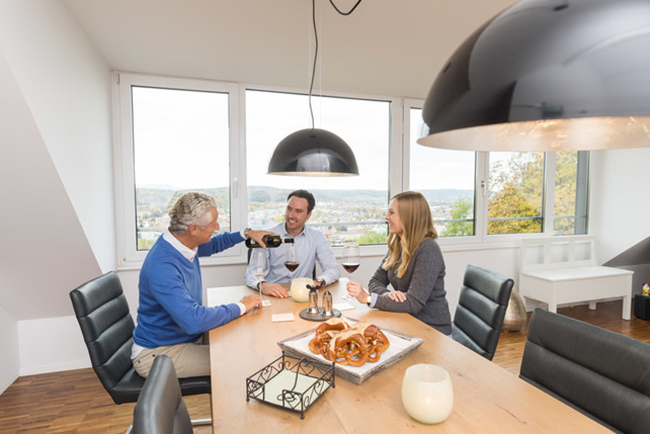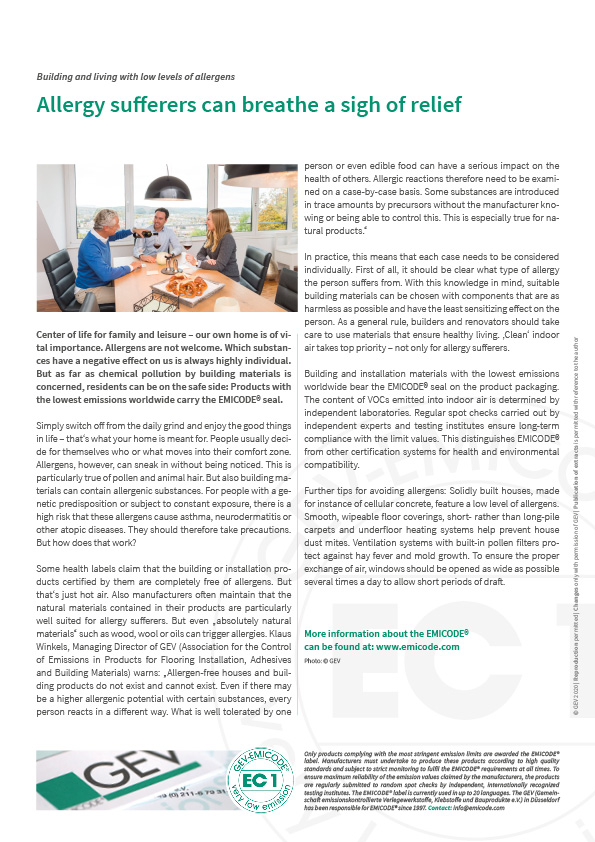Allergy sufferers can breathe a sigh of relief
Building and living with low levels of allergens
Simply switch off from the daily grind and enjoy the good things in life – that’s what your home is meant for. People usually decide for themselves who or what moves into their comfort zone. Allergens, however, can sneak in without being noticed. This is particularly true of pollen and animal hair. But also building materials can contain allergenic substances. For people with a genetic predisposition or subject to constant exposure, there is a high risk that these allergens cause asthma, neurodermatitis or other atopic diseases. They should therefore take precautions. But how does that work?
Some health labels claim that the building or installation products certified by them are completely free of allergens. But that’s just hot air. Also manufacturers often maintain that the natural materials contained in their products are particularly well suited for allergy sufferers. But even “absolutely natural materials” such as wood, wool or oils can trigger allergies. Klaus Winkels, Managing Director of GEV (Association for the Control of Emissions in Products for Flooring Installation, Adhesives and Building Materials) warns: “Allergen-free houses and building products do not exist and cannot exist. Even if there may be a higher allergenic potential with certain substances, every person reacts in a different way. What is well tolerated by one person or even edible food can have a serious impact on the health of others. Allergic reactions therefore need to be examined on a case-by-case basis. Some substances are introduced in trace amounts by precursors without the manufacturer knowing or being able to control this. This is especially true for natural products.”
In practice, this means that each case needs to be considered individually. First of all, it should be clear what type of allergy the person suffers from. With this knowledge in mind, suitable building materials can be chosen with components that are as harmless as possible and have the least sensitizing effect on the person. As a general rule, builders and renovators should take care to use materials that ensure healthy living. “Clean” indoor air takes top priority – not only for allergy sufferers.
Building and installation materials with the lowest emissions worldwide bear the EMICODE® seal on the product packaging. The content of VOCs emitted into indoor air is determined by independent laboratories. Regular spot checks carried out by independent experts and testing institutes ensure long-term compliance with the limit values. This distinguishes EMICODE® from other certification systems for health and environmental compatibility.
Further tips for avoiding allergens: Solidly built houses, made for instance of cellular concrete, feature a low level of allergens. Smooth, wipeable floor coverings, short- rather than long-pile carpets and underfloor heating systems help prevent house dust mites. Ventilation systems with built-in pollen filters protect against hay fever and mold growth. To ensure the proper exchange of air, windows should be opened as wide as possible several times a day to allow short periods of draft.

Photo: ©GEV
Center of life for family and leisure – our own home is of vital importance. Allergens are not welcome. Which substances have a negative effect on us is always highly individual. But as far as chemical pollution by building materials is concerned, residents can be on the safe side: Products with the lowest emissions worldwide carry the EMICODE® seal.

Do You Have Questions?
If you have questions about specific topics or if you would like to contact us for any other reason, feel free to contact us by phone, fax or e-mail.
Phone: +49 211 / 67931-20
Fax: +49 211 / 67931-33
info@emicode.com
Share article on Social Media:
